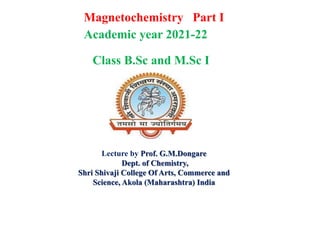
Magnetochemistry Part I: Study of Magnetic Properties of Materials
- 1. Magnetochemistry Part I Lecture by Prof. G.M.Dongare Dept. of Chemistry, Shri Shivaji College Of Arts, Commerce and Science, Akola (Maharashtra) India Academic year 2021-22 Class B.Sc and M.Sc I
- 2. Magnetism-Background • Magnetochemistry is the study of the magnetic properties of materials. By "magnetic properties" we mean not only whether a material will make a good bar magnet, but whether it will be attracted or repelled by a magnet. This includes synthesis, analysis and understanding. This short description is meant to give a basic understanding before you delve into a more complex treatment. • Magnetism arises from moving charges, such as an electric current in a coil of wire. In a material which does not have a current present, there are still magnetic interactions. Atoms are made of charged particles (protons and electrons) which are moving constantly. • Each spinning electron causes a magnetic field to form around it. In most materials, the magnetic field of one electron is cancelled by an opposite magnetic field produced by the other electron in the pair. • The atoms in materials such as iron, cobalt and nickel have unpaired electrons, so they don't cancel the electron’s magnetic fields. • As a result, each atom of these elements acts like a very small magnet.
- 3. The processes which create magnetic fields in an atom • Nuclear spin. Some nuclei, such as a hydrogen atom, have a net spin, which creates a magnetic field. • Electron spin. An electron has two intrinsic spin states (similar to a top spinning) which we call up and down or alpha and beta. • Electron orbital motion. There is a magnetic field due to the electron moving around the nucleus. • Each of these magnetic fields interact with one another and with external magnetic fields. However, some of these interactions are strong and others are negligible.
- 4. The magnetic moment of a single atom(μ) • μ is a vector • μ= i F [Am2], circular current i, area F μB= eh/4πme= 0.9274 10-27Am2 (h: Planck constant, me: electron mass) μB: “Bohr magneton” (smallest quantity of a magnetic moment) • For one unpaired electron in an atom μs = 1.73 μB; μs = spin only magnetic moment • The magnetic moment of an atom has two components a spin component(“spin moment” ) and an orbital component(“orbital moment”). →Frequently the orbital moment is suppressed (“spin-only- magnetism”, e.g. coordination compounds of 3d elements)
- 5. Magnetism • when a substance is placed within a magnetic field, H, the field within the substance, B, differs from H by the induced field, 4πI, which is proportional to the intensity of magnetization, I. That is; B = H + 4πI where B is the magnetic field within the substance H is the applied magnetic field and I is the intensity of magnetisation This can also be written as B/H = 1 + 4π I/H, or B/H = 1 + 4 π Where B/H is called the magnetic permeability of the material and is the magnetic susceptibility per unit volume, (I/H) The classical theory of magnetism was well developed before quantum mechanics. Lenz's Law (~1834), states that:
- 6. Magnetism By definition, in a vacuum is zero, so that B=H. It is usually more convenient to measure mass (gram) susceptibility, χg, which is related to the volume susceptibility through the density. χg = /ρ where ρ is the density. Finally to get our measured quantity on a basis that can be related to atomic properties, we convert to molar susceptibility χm = χg x MW ; (MW = molecular weight of the sample) χm = Nμ2 / 3kT where N is Avogadro's Number; k is the Boltzmann constant and T the absolute temperature Rewriting this gives the magnetic moment as μ = 2.828 χmT = 2.828(χmT)1/2
- 7. Magnetic States of Matter Diamagnet - A diamagnetic compound has all of it's electron spins paired giving a net spin of zero. Diamagnetic compounds are weakly repelled by a magnet. Paramagnet - A paramagnetic compound will have some electrons with unpaired spins. Paramagnetic compounds are attracted by a magnet. Paramagnetism derives from the spin and orbital angular momenta of electrons. This type of magnetism occurs only in compounds containing unpaired electrons, as the spin and orbital angular momenta is cancelled out when the electrons exist in pairs. Compounds in which the paramagnetic centers are separated by diamagnetic atoms within the sample are said to be magnetically dilute. If the diamagnetic atoms are removed from the system then the paramagnetic centres interact with each other. This interaction leads to ferromagnetism (in the case where the neighboring magnetic dipoles are aligned in the same direction) and antiferromagnetism (where the neighboring magnetic dipoles are aligned in alternate directions).
- 8. Different types of collective magnetism in a solid due to coupling of magnetic moments
- 9. Curie-und Curie-Weiss law for paramagnetic samples
- 10. Curie-und Curie-Weiss law for paramagnetic samples Curie: 1/χ= C•T; Curie-Weiss: 1/χ= C•(T-Θ)
- 12. Curie Constant
- 13. Curie-und Curie-Weiss law for paramagnetic samples Curie: 1/χ= C•T; Curie-Weiss: 1/χ= C•(T-Θ)
- 14. Magnetism in solids (cooperative magnetism) Diamagnetism and paramagnetism are characteristic of compounds with individual atoms which do not interact magnetically (e.g. classical complex compounds) Ferromagnetism, anti-ferromagnetism and other types of cooperative magnetism originate from an intense magnetical interaction between electron spins of many atoms
- 15. Magnetism Diamagnetism • External field is weakened • Atoms/ions/molecules with closed shells -10-4 < χm < -10-2 cm3/mol (negative sign) Paramagnetism (van Vleck) • External field is strengthened • Atoms/ions/molecules with openshells/unpairedelectrons 10-4 < χm < 10-1 cm3/mol diamagnetism(core electrons) + paramagnetism (valence electrons) Pauli-Paramagnetism: →special type of magnetism of the conduction electrons in metals →refers only to the free electrons in the electron gas of a metallic solid) 10-6 < χm < 10-5 cm3/mol
